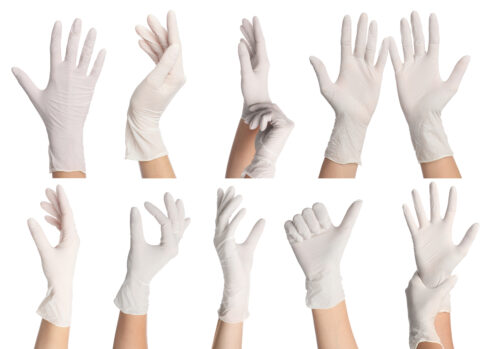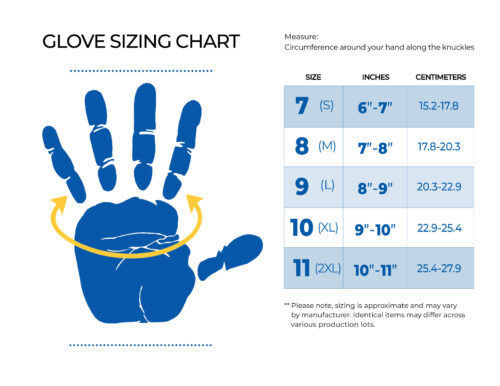

Medical gloves are personal protective equipment designed to protect both the wearer and the patient from the spread of germs, illness, and infection. All gloves used in dentistry are, by definition, medical gloves. According to the U.S. Food & Drug Administration (FDA), medical gloves include examination gloves, surgical gloves, and chemotherapy gloves, which are gloves specifically designed to handle contact with chemotherapy agents. Choosing the correct glove is one of the simplest yet most essential pieces of maintaining hygienic standards and ensuring the safety of your patients.
Dentistry is a high-risk profession. The chance of practitioners and patients being exposed to unseen threats is always present. Thus, safety measures aimed at lowering these probabilities encourage medical staff to constantly use disposable gloves as a part of their daily routines.

It is an indisputable fact that medical gloves protect against dangerous chemicals and microbes. Additionally, variations of medical gloves made from different polymers possess special properties for specific purposes. Hence, determining what kind of medical glove should be used in your dental clinic should be an essential part of the risk reduction process.
Wearing gloves that fit properly is essential to ensure that they provide the best protection. Here are some tips to help you ensure that your medical gloves fit your hands correctly:
Remember that gloves are made to specific standards, but there is a wide range within each size and fit varies greatly based on material. It’s important to try on different sizes and brands to find the best fit for you.
To ensure that gloves provide the best protection, it’s essential to wear gloves that fit properly. Here are some tips to help you ensure that your medical gloves fit your hands correctly:
Measure the circumference of your dominant hand: Your dominant hand is the key factor when selecting the right glove size. The size of your dominant hand will determine the glove size you need. Start by measuring your dominant hand’s circumference around the knuckles, excluding your thumb. Once you have your measurements, refer to a glove size chart to find your size.

Image courtesy of Stauffer Glove & Safety.
Take another measurement from the tip of your middle finger: While referring to your dominant hand as the main factor in determining your glove size is fine, you should also take another measurement from the tip of your middle finger. This will help you get a better fit, as the size of your middle finger can vary from your knuckles. To measure your middle finger, hold it straight and measure from the tip of your finger to the base of your palm.
Try on a few gloves from different manufacturers: Every medical supply manufacturer has varying sizes, so trying on a few different gloves from different manufacturers is important to find the one that fits you best. Consider the type of procedure you will be performing and select gloves with an appropriate thickness.
To learn more about finding the correct fit, check out this article at our blog, The Daily Floss.
There are several variants of disposable medical gloves that possess different levels of protection, comfort, and durability. In the medical field, the most-used gloves are made from latex, nitrile, or chloroprene. There are even medical-grade gloves that are made from vinyl.
This type of disposable glove comes from a rubbery synthetic material best known under the registered trademark Neoprene.
These are similar to nitrile-made gloves in terms of puncture resistance and protection against hazards during treatment. However, the molecular structure is closer to that of natural rubber latex, providing comfort and durability like latex-type disposable gloves.
Chloroprene gloves do not contain the proteins found on latex gloves which often trigger allergic reactions. While chloroprene gloves are typically more expensive than latex variants, they are still more affordable than their nitrile counterparts.
This type of disposable glove comes from a substance found on mature rubber trees. Its ability to perfectly fit a users’ hand while enabling precise and high-tactile sensitivity makes latex-made gloves the go-to disposable option across industries.
Latex gloves provide the highest level of protection against viruses and bacteria. However, against chemicals, it has a weaker barrier compared to other types of gloves.
Latex gloves are cheaper than most of the alternatives in the market. Despite that fact and the advantages of comfort and protection, latex gloves can trigger latex allergies in some users. Consequently, this drawback has forced some offices to opt for disposable chloroprene or nitrile gloves as a substitute.
Often referred to as “medical-grade,” nitrile gloves are made of synthetic rubber.
Nitrile gloves are superior to other types when it comes to puncture and chemical resistance, as well as protection from viruses.
Many consider disposable nitrile gloves to be the highest quality substitute for latex gloves. They are the strongest option in terms of durability and long shelf life, while significantly reducing any chance of allergies that come from latex gloves.

There are various types of alternative disposable gloves, many coming with extra specifications that allow users added protection. However, adding extra elements to the usual composition of gloves comes with unique benefits and drawbacks compared to the standard options. Below are some different glove options along with their counterparts.
For many years, powdered gloves were used because they were considered easier to wear. The powdered coating made them easier to put on and take off. However, in late 2016, the FDA banned all powdered surgical gloves and exam gloves. The powder was found to be a risk to patient health: it can trigger severe airway inflammation and hypersensitivity reactions. Additionally, the body’s antibody response to powder particles can cause surgical complications.
Since 2017, all gloves for surgical or exam purposes must be powder-free. The ease of use of powder-free gloves did not offset the potential risks to patient health. The lack of residue in powder-free gloves reduces the chances of an allergic reaction or airway inflammation. Therefore, all disposable gloves for use in a medical setting have to be powder-free.
All gloves are now powder-free, but there are still options for gloves that have been treated to add to their utility. Users can choose to use chlorinated or non-chlorinated disposable gloves, each with their own benefits.
This type of glove, as the name suggests, is treated with chlorine instead of powder, resulting in powder-free gloves with all the ease-of-use advantages of powdered ones. Chlorinated gloves are made by exposing the gloves to chlorine gas or hypochlorite-hydrochloric acid mixture to harden the surface of the glove. The glove remains flexible, but hardening the surface makes the gloves slide on and off more easily.
The disadvantage of chlorine-treated gloves is their shorter shelf life, which only lasts for a year or less if exposed to heat. You can identify old or over-chlorinated gloves by the color: they turn dark yellow or brown instead of the expected lighter color. Also, these gloves do carry the scent of chlorine, which may not be desirable for all uses.
Meanwhile, chlorine-free gloves are regular exam gloves but without the odor of chlorine. For some types of chlorine-free gloves, the gel/silicone coating can be more likely to trigger allergies than its chlorinated counterpart. However, non-chlorinated gloves last longer and can remain on shelves for up to 3 to 5 years, depending on the material.
These gloves are medical-grade and generally used for actual procedures. Their specific purpose requires that these gloves undergo a sterilization process that reduces the threat of cross-contamination. The only difference between exam gloves and surgical gloves is the latter being of a higher-quality grade that offers more precise sizing and higher tactile sensitivity.
There also gloves that present protection for more specific tasks as well as increased comfort:
A glove option that adds protection from chemotherapy-specific drugs during use. Chemotherapy-tested gloves must be disposable and powder-free, and need to be made from nitrile, neoprene, or latex, according to the Oncology Nursing Society. There are a range of gloves that are chemo rated (indicated to meet the minimum needs for contact with chemotherapy drugs), including PURPLE NITRILE* Exam Gloves.
Gloves with aloe vera moisturize hands while gloves are worn. This offers a soothing option for hands suffering from drying out or becoming chapped due to over-washing. These gloves use aloe vera to reduce friction and irritation, and can sooth dry or damaged hands in some cases.
Similarly to gloves with aloe vera, this glove option assists in the prevention and protection of dry skin. Exam gloves with oatmeal are designed to help soothe and restore moisture to irritated hands. The colloidal oatmeal in the gloves creates a barrier between skin and glove, helping to maintain moisture and keep skin softer.
There is no real answer to which glove option is best. All of the options above are designed for particular users, procedures, and preferences. First-time purchasers should carefully consider the frequency of use and their sensitivity to allergies. Ultimately, the best decision is to have at least one of each glove variant readily available just in case it is necessary, and to consult with a professional regarding the specific needs of your practice and your staff.
If you would like more in-depth information, need to purchase disposable medical gloves, or just want to chat with one of Benco Dental’s friendly reps, you can click here to find the best option for your practice.